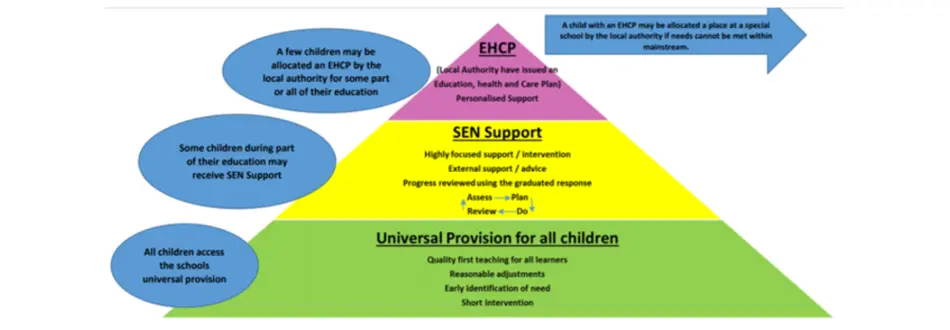The type and level of support children and young people need will be different. The Areas of Need – The Graduated Approach section of the toolkit provides guidance for schools on how to meet children’s needs within mainstream primary and secondary schools. Overviews of the four broad areas of SEND described within the SEND Code of Practice have been written for parents and carers and can be found on the Overviews of the four broad areas webpage.
A question guide for parents and carers has also been created linked to this toolkit, to support you in discussions with school to understand how the graduated approach is being used to support your child. This guide can be access below.
(The PDF below is not fully accessible and may not be suitable for users of assistive technology. See: Document accessibility).
- pdf file

The diagram above illustrates how children with SEND should be supported in schools as follows:

Most children and young people make progress in school or college with the Universal Provision, or the general support and good quality teaching provided for all children and young people (sometimes called Ordinarily Available Provision).

Some children and young people might need more support at school or college in addition to Ordinarily Available Provision or the 'whole-setting' offer. This is known as ‘SEN Support’. The amount, type and focus of support that children and young need at school or college will be different and might change over time. For example, some children and young people may require a limited number of 'booster' sessions in an area of learning they have struggled with, whereas others may require more individualised support for a longer period of time.

Few children and young people will need a higher level of support over time. This might be the case where there are ongoing concerns regarding a child/young person's expected progress (with extra support to meet their needs having been in place for some time) and/or where their needs are having a considerable impact on learning or access to education. In these cases, schools and colleges should consider requesting an Education, Health and Care (EHC) needs assessment. Children and young people over the age of 16 and parents/carers can also request this themselves.
Most schools keep something called a "SEN list" – this is a list of children and young people who have been identified as needing additional support in one or more areas. The SEN list is revisited and reviewed regularly, which means that children and young people can be added or removed at any time. You might hear the term "SEN Support" which is a broad term used to describe support in schools and colleges for children and young people who have been identified as needing some additional help.